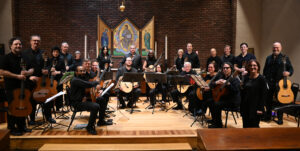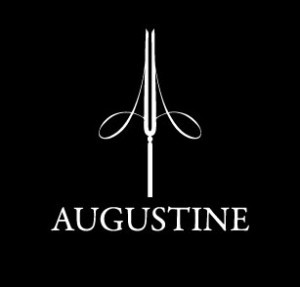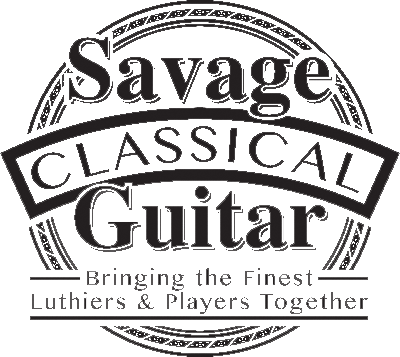by Mark Greenberg
February 2005
Mannes Guitar Ensemble
December 10, 2004
Mannes College of Music
Over thirty years ago (maybe 1972 or 1973?), and around this time of year (late November or early December), I visited Mannes for the first time, to see the student guitar soloists. Students performing that evening included Herbert Levine, who played some Bach; Janet Marlowe; and Fred Hand. I think Fred played Dowland. As a final number, as sort of a party trick, Janet and Herb did an Elizabethan duet — Cutting or Johnson or some such. I thought it was some of the best playing I had ever heard.
Over thirty years later, on December 8th and 10th, I was back at Mannes, to see first the guitar soloists and then the guitar ensemble. In the soloist concert, by the time the program got to Giacomo La Vita … that was some of the best playing I’ve ever heard. But that’s all I want to say about the soloists. (Except — if anyone out there from Naxos Records is listening — sign up Mr. La Vita right away, I mean forthwith!)
It is the ensemble that is quite different. Thirty years ago, playing duo guitar, let alone trio and quartet, was almost an unnatural act, like a dog walking on two legs. In the dim days of the late Sixties, guitarists often had to play an orchestral instrument also. Herb Levine paid part of his way through Mannes by playing French horn (damn well!) in the Mannes Orchestra. There were actually guitar teachers (I won’t name names) who didn’t consider sight reading an important skill; only memorization and virtuoso playing were deemed essential to the soloist. And no one came to Mannes as a guitarist planning to end up in “ensemble” (though a fair number of Mannes-trained guitarists have ended up as conductors!).
Today, the situation is radically different. Part of that is due to musical evolution, and the success of guitar quartets, trios, duos, etc, etc. But another huge factor is the ensemble director, Terry Champlin. For those who don’t know of Mr. Champlin, let me say that he is one of the best writers of original guitar ensemble music on the planet; his work is invariably lovely and highly effective. But that’s all I want to say about Terry Champlin as a composer. (Except — if anyone out there from the LAGQ is listening — you should be playing this guy’s music right away, I mean forthwith! Do you hear me, O my brother, Bill Kanengeiser?)
What I really want to talk about is the superlative richness of his ensemble program, and how it would fill (if it were general knowledge) every seat in the Mannes Concert Hall.
For openers were wonderful folk songs set by Brahms and Beethoven, sensitively performed by Paul Michael Smith on guitar, and beautifully sung by his accompanist (as they never say in the Times), tenor Dan Molkentin. (Yeah, yeah, I happen to know that the singer is supposed to get top billing. But was this a guitar ensemble recital or what?)
Next was a Mozart Divertimento, K. 229, that is nominally not supposed to work on three guitars (not enough cantabile, heh?) but actually came off superbly thanks to the legato playing of the super-young-looking Jorge Gavidia, that James Dean of the guitar, Kurt Toriello, and ringer-in-residence, Mr. Champlin.
The penultimate piece of the first half of the recital was another TTT (Terrific Toriello Transcription — complete with performance) of the Schubert Arpeggione, never before attempted on guitar (Never? Well … almost never) with fine work in the violin part by Hyun-Jung Kim.
The first half of the recital concluded with excellent visits to two Albéniz cities of España — Sevilla and Cadiz — by Bret Williams and Mr. La Vita, This was no party trick, but superb duo playing; true, both players had memorized and played with virtuosity, but they also cued and communicated with each other at a very high level of musicianship.
Could the second half of the program be any better? Yes, it could. Well, maybe not better, but even more diverse and unusual.
First came Cajon, a guitar trio composed in 1976 by Jorge Sosa, who sat in attendance in the audience. This is a percussive work, molto knocking on wood, given a dynamite performance by Mr. Smith, Adam Tully, and Mr. La Vita. It goes without saying that it knocked us all out.
While one may occasionally hear equally superb duo playing on the Mannes stage, how often is a harp hauled onstage (lemme tell you, it ain’t easy) for a weekday student recital? The result was an exquisite performance of a rarely-heard harp, guitar and mandolin trio, a ravishing work by Hans Werner Henze.
The exquisite performers were Mr. La Vita again, Kathryn Andrews on harp, and Adam Tully, who had played such excellent guitar only moments earlier and was now revealed as equally excellent mandolinist. Who’d have guessed?
The evening concluded with Fantasia for Guitar Quartet by Terry Champlin, and it was the usual lovely work that typifies his writing: highly melodic, with expert idiomatic knowledge of the guitar. Sylwia Kloc voiced the first guitar part beautifully, and Andrew Dickenson, Paul Smith and Terry Champlin brought this very rich and satisfying evening to a perfect end.
As Chopin might say: Nothing is more beautiful than a guitar except two guitars … or three guitars … or four guitars … or a guitar and a harp and a mandolin or …









